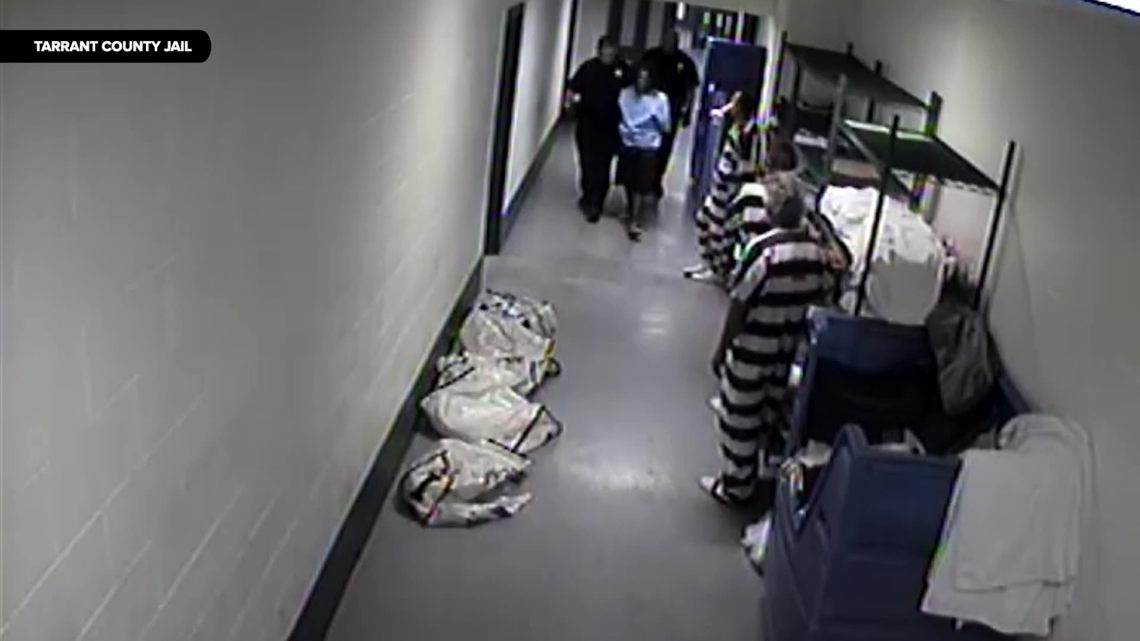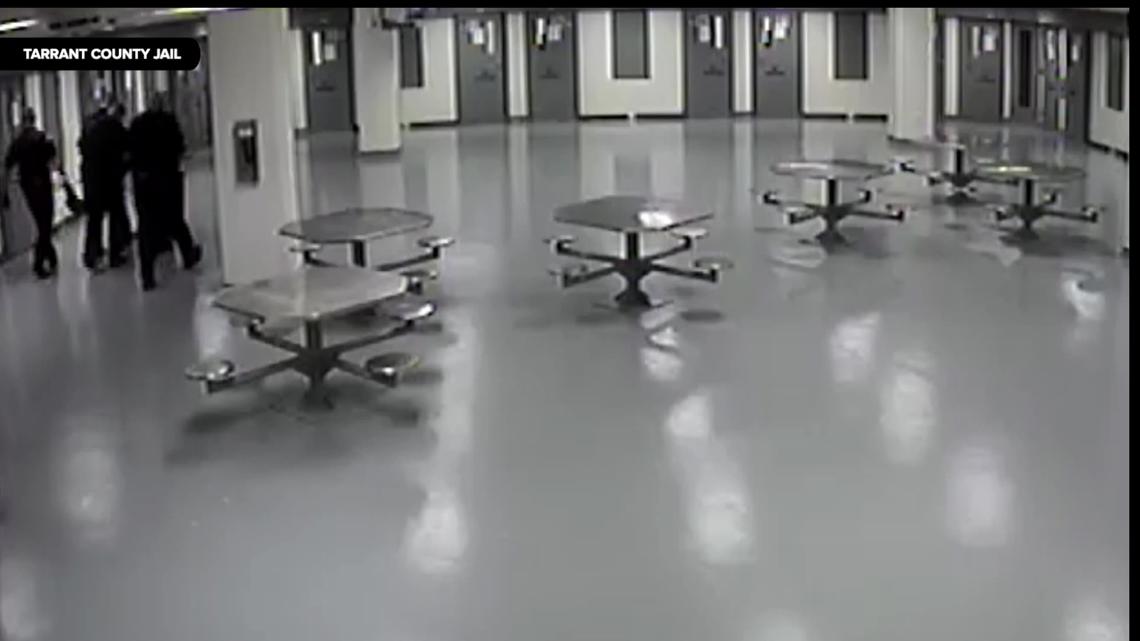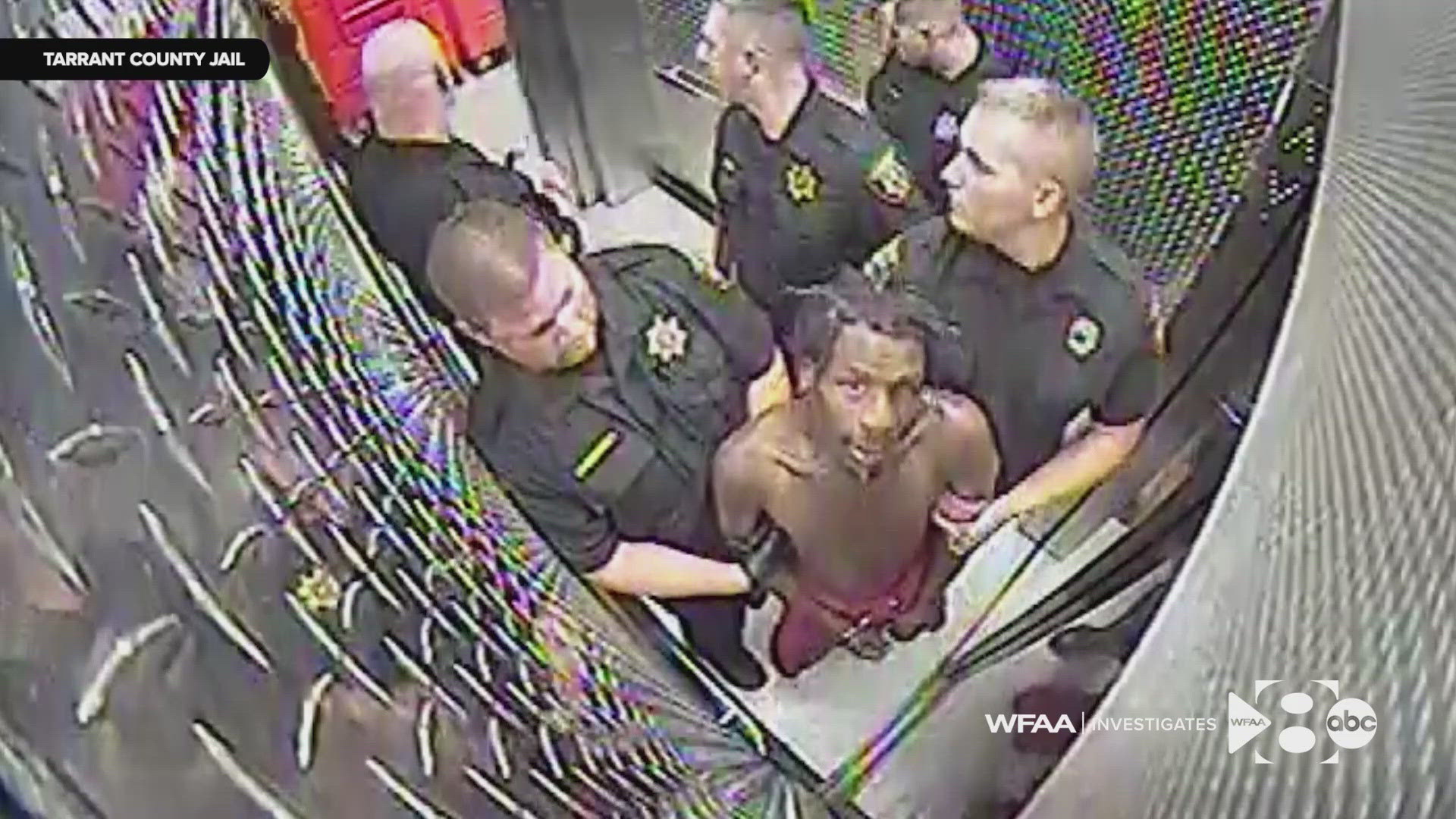FORT WORTH, Texas — Five years ago, Robert Miller died after being repeatedly pepper sprayed in the Tarrant County jail.
And for five years, his widow, Shanelle Jenkins, waited to see the video of his final moments.
She met WFAA in July at one of her husband’s favorite places: the Fort Worth Water Gardens. So, it was against a backdrop of rushing water – an oasis of calm – that she chose to witness the chaos.
“I’m really scared to see Robert suffer that bad,” she told WFAA.
For years, the county refused to release the videos to her attorneys or the public.
But WFAA got them through an open records request after a federal judge dismissed Jenkins’ lawsuit against the county.
“We have been requesting formally and informally for the county to release this video for years,” said Jay Ellwanger, Jenkins’ attorney. “We’d always been stymied in the process -- at one point even being told that the videos didn't exist.”
Since 2017, 65 prisoners died while being held in the Tarrant County jail. Two of those deaths -- Shanelle’s husband, Robert Miller, and the recent case of former Marine Anthony Johnson -- happened after guards used pepper spray.
Unlike the Fort Worth Water Gardens he loved so much, Robert Miller’s life was far from peaceful. He suffered from mental illness and lived on the streets of Fort Worth for at least a decade.
“He was in and out of jail,” his wife said.


Willie Miller, his father, said that he began showing signs of mental illness even as a young boy.
“Sometimes he was alright, and sometimes he goes left field,” his father recalled.
On July 31, 2019, Fort Worth police officers arrested Miller at a homeless encampment on eight Class C misdemeanor warrants including panhandling and public intoxication.
Police records say Miller became combative once officers told him he could not take his belongings with him to jail. He began “kicking” at the patrol car, and spitting and kept saying, “I hate the police” during the trip to the jail, records show.
The video
From here, Miller’s time in the county jail is documented, partially, by a newly released video.
Officers took him first to the police department’s holding cell. Miller spent several hours there. He appeared agitated. The video, which lacks sound, shows him kicking and hitting the doors and arguing with officers.
“I know my Robert,” his wife said as she watched the video for the first time. “He was probably, saying, ‘This was bull crap, the reason they picked me up in the first place.’”
Officers brought him over to the main county jail, where records show jailers questioned him about his medical and mental health history. A jail supervisor later wrote that Miller “became agitated and refused to follow orders” and told them, “I do not want to kill myself, but I want to kill y’all cops.”
“Once a person makes that statement, you have now been put on notice,” said Lenard Vare, a retired prison warden who serves as an expert in jail death cases. “Because of that, I would have the video cameras on him the whole time.”
Instead, what the jail videos show is guards took Miller into a room with no cameras to change him into jail clothing. Jail regulators in Texas don’t allow surveillance cameras in areas where inmates might be unclothed. However, the rules do not prohibit jailers from wearing body cameras or carrying a hand-held camera in such areas.


Vare said when he was a warden, his guards wore body cameras when in similar volatile situations. Jailers should not have taken Miller into a room where there were no cameras, he said. And, they could have delayed putting him into jail clothes.
“That was an error in judgment,” Vare said. “They should have kept him secure by himself and once mental health has had a chance to kind of evaluate it fully, then you can make a decision on what to do next.”
Sheriff Bill Waybourn declined a WFAA interview request, but he spoke about Miller’s case earlier this year at a town hall.
He said that Miller began to fight jailers and, as a result, pepper sprayed to bring “him under compliance.”
“Nobody hit him,” the sheriff said. “He was restrained.”
Although there is no video of Miller in the changing area, a jail supervisor’s written statement to investigators says that Miller tried to headbutt one of the jailers and then was pepper sprayed three times. The supervisor said jailers showered Miller and then took him for medical screening.
“He saw medical, he refused medical,” Sheriff Waybourn said at the town hall. “In fact, he resisted medical, and he threatened nurses.”
According to jail medical records, Miller told the medical staff, “I need water. I have asthma. I can’t breathe.”
“Patient is continuously moving and was unable to get vitals,” the medical records say.


Aftermath on video
While the videos don’t show Miller being pepper sprayed, the released videos do show him when he’s escorted from the room to his jail cell. He appears barely able to walk. At times, jailers seem to be holding him up.
“Look at him, he’s just limp,” Jenkins said as she watched the video.
As Miller’s father watched the videos, his hands shook in anger. His father was left wheelchair-bound by an on-the-job accident that occurred decades ago.
“I need a drink bad,” he said, his voice shaking. “Help me, Lord. Please help me.”
“I don’t understand why he’d be walking to his cell in this condition,” said attorney David Henderson, one of Jenkins’ attorneys, as he watched the video. “He looks like somebody who needs medical attention.”
The videos show jailers as they escorted a barefoot Miller up to the cell block.
“As we entered the housing unit, inmate Miller refused to walk,” the jail supervisor wrote in his statement.
The video shows jailers carrying Miller to his cell – face down by his legs and arms – and leaving him there.


There is no video of Miller in his jail cell. However, records say jailers returned periodically to conduct their required cell checks.
A jailer says he saw Miller “reaching into a toilet to splash water on himself,” according to Texas Rangers records. Jailers told investigators they asked Miller if he needed medical attention and he shook his head “no.”
“The big question that I will have is, was he fully decontaminated?” said Vare, the jail expert. “Did he get enough water? Did they get the chemicals out of his system?”
Vare says that instead of leaving Miller in a cell, jailers should have kept Miller under constant observation for several hours after he was sprayed.
“If you're watching him and you notice that the person is going into cardiac arrest, the deputies can respond immediately,” Vare said.
Vare told WFAA the videos show a “failure to plan, a failure to anticipate and a failure to train.” He also said that Miller should have been placed in a restraint chair to protect himself and the jailers as they moved him through the jail.
He also said the county should consider investing in body cams for jailers to better document use-of-force incidents.
Forty-five minutes after jailers put him in a cell, they found Miller lying on the floor, not breathing. Video shows paramedics trying to revive him.
At 5:45 a.m. on Aug. 1, 2019, Miller died at John Peter Smith Hospital. He’d arrived at the Tarrant County Jail almost 16 hours earlier on a criminal mischief charge that stemmed from allegations that he damaged a squad car while being taken to jail.
Jenkins said she learned of her husband’s death in the newspaper.
“He went in walking and talking,” she told WFAA. “He came out limp, unresponsive.”


‘File closed’
For Robert Miller’s family, news of his death was aggravated by how the Tarrant County Medical Examiner classified how he died.
Ten months after his autopsy, the M.E.’s office ruled he died of a “sickle cell crisis” and that it was a natural death. The autopsy notes that he was pepper sprayed, and that he had asthma, but the pathologist found that neither was a factor in his death.
After that ruling, the Texas Ranger investigating Miller’s death wrote, “I anticipate no further involvement in this investigation. … File closed.”
But it was far from closed in the minds of Miller’s family and the public. Activists have protested his death for years at Tarrant County Commissioner’s Court.
In October 2022, WFAA’s media partners at the Fort Worth Star-Telegram published a lengthy investigation questioning Miller’s cause of death.
“There is no evidence that Mr. Miller died from a sickle cell crisis,” said sickle cell expert Hannah Litchsinn, an internal medicine doctor in Minnesota.
Litchsinn reviewed Miller’s medical records and autopsy. She said records show that while Miller carried the sickle cell trait, he did not have sickle cell disease.
“Sickle cell trait is not the same thing as sickle cell disease,” Lichtsinn said. “Sickle cell trait is what happens when someone has one normal hemoglobin gene and one sickle cell trait gene. And it is not clinically significant except in some very, very rare and extreme situations.”
As many as 10 percent of Black Americans carry the trait -- a genetic mutation that came about, according to experts, as a way to protect against malaria.
In 2021, the New York Times found dozens of in-custody deaths of Black people being blamed on sickle cell crisis. As a result, the American Society of Hematology issued a statement: “The use of sickle cell to cover up the deaths of Black people is abhorrent and has no scientific or medical merit.”
The ASH said in its statement that “sudden death is extraordinarily rare in sickle cell trait and the finding of sickle cell trait is unlikely to supersede other inflicted traumas as the cause of death or major factor in death.” The group also said it was “medically inaccurate to claim sickle cell crisis as a cause of death based on solely on the presence of sickled cells at autopsy.”
“I think it's hard to argue that anything other than what happened in that room is what led to his death,” Litchsinn said. “Pepper spray itself is a toxic substance. But if you add that to someone who already has a compromised respiratory system it is even more dangerous.”
A fresh look?
As a result of the Star-Telegram’s investigation, county commissioners hired an outside pathologist to review Miller’s autopsy. At the same time, the county also sent Miller’s blood samples off to the Mayo Clinic.
The Tarrant County Medical Examiner’s office also amended Miller’s autopsy to include a lengthy defense of the sickle cell crisis finding.
But the office also changed the manner of his death from being natural to undetermined. That meant the M.E. couldn’t decide if it was a natural death, a homicide or perhaps accidental.
The Medical Examiner’s Office did not respond to WFAA requests for comment.
The Tarrant County Sheriff’s office says jailers followed policy and their training in the Miller case.
Clutching a photo of their son, now 14, as an infant, Shanelle said, “This is all I have left of Robert right here. He looks just like Robert.”
“I have no answers to give to my child when he gets old enough to fully understand,” she said. “We all know this was a homicide.”
Email investigates@wfaa.com

